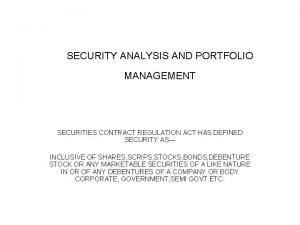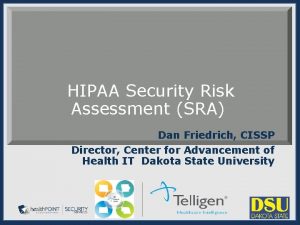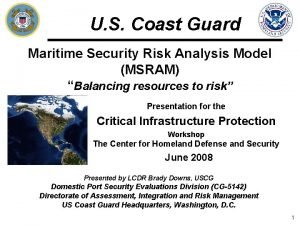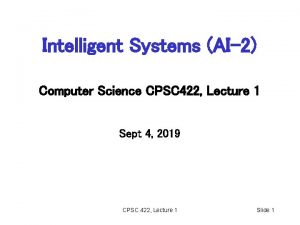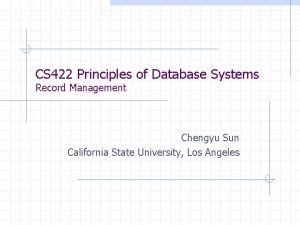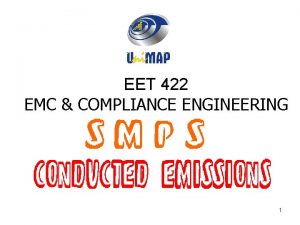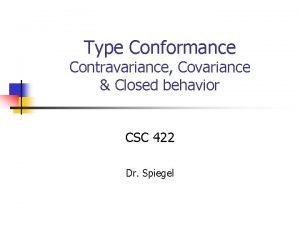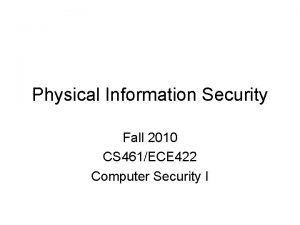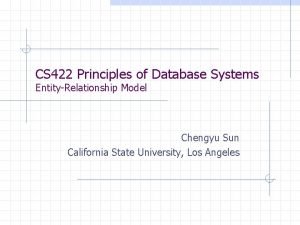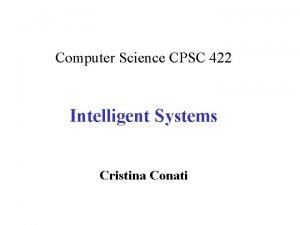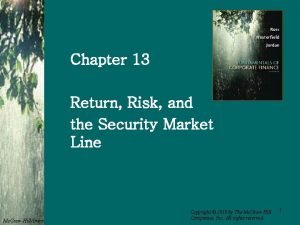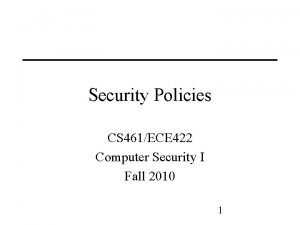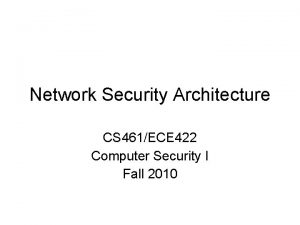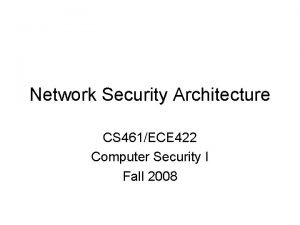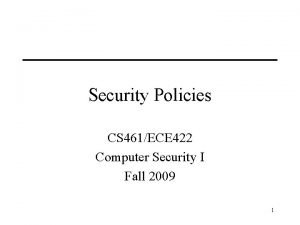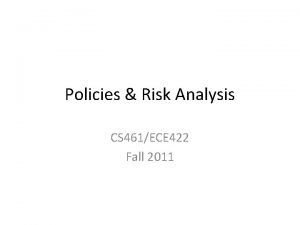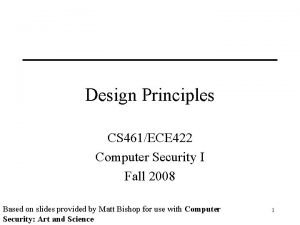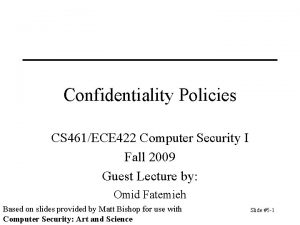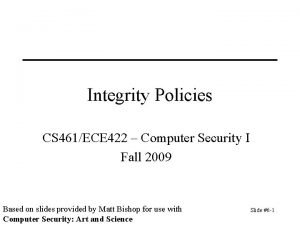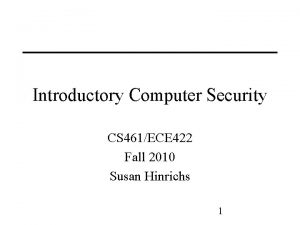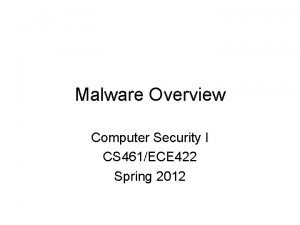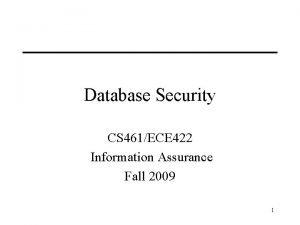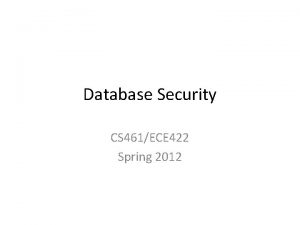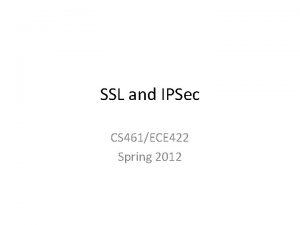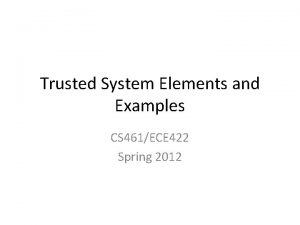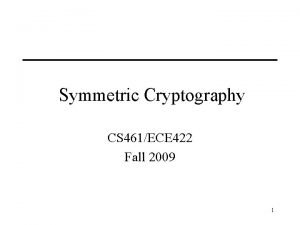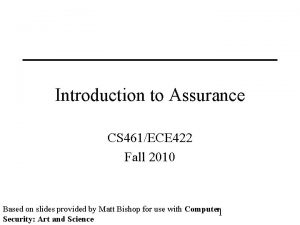Security Planning and Risk Analysis CS 461ECE 422
































- Slides: 32

Security Planning and Risk Analysis CS 461/ECE 422 Computer Security I Fall 2010 1

Overview • Elements of Risk Analysis • Quantitative vs Qualitative Analysis • One Risk Analysis framework 2

Reading Material • Chapter 1. 6 of Computer Security • Information Security Risk Analysis, by Thomas R. Peltier – On reserve at the library – Chapters 1 and 2 on compass site – Identifies basic elements of risk analysis and reviews several variants of qualitative approaches 3

What is Risk? • The probability that a particular threat will exploit a particular vulnerability – Not a certainty. – Risk impact – loss associated with exploit • Need to systematically understand risks to a system and decide how to control them. 4

What is Risk Analysis? • The process of identifying, assessing, and reducing risks to an acceptable level – Defines and controls threats and vulnerabilities – Implements risk reduction measures • An analytic discipline with three parts: – Risk assessment: determine what the risks are – Risk management: evaluating alternatives for mitigating the risk – Risk communication: presenting this material in an understandable way to decision makers and/or the public 5

Risk Management Cycle From GAO/AIMD-99 -139 6

Basic Risk Analysis Structure • Evaluate – – Value of computing and information assets Vulnerabilities of the system Threats from inside and outside Risk priorities • Examine – Availability of security countermeasures – Effectiveness of countermeasures – Costs (installation, operation, etc. ) of countermeasures • Implement and Monitor 7

Who should be Involved? • Security Experts • Internal domain experts – Knows best how things really work • Managers responsible for implementing controls 8

Identify Assets • Asset – Anything of value – Physical Assets • Buildings, computers – Logical Assets • Intellectual property, reputation 9

Example Critical Assets • • People and skills Goodwill Hardware/Software Data Documentation Supplies Physical plant Money 10

Vulnerabilities • Flaw or weakness in system that can be exploited to violate system integrity. 11

Example Vulnerabilities • Physical • V 01 Susceptible to unauthorized building access • V 02 Computer Room susceptible to unauthorized access • V 03 Media Library susceptible to unauthorized access • V 04 Inadequate visitor control procedures • (and 36 more) • Administrative • V 41 Lack of management support for security • V 42 No separation of duties policy • V 43 Inadequate/no computer security plan policy • V 47 Inadequate/no emergency Communications action plan • V 87 Inadequate communications • (and 7 more) system • Personnel • V 88 Lack of encryption • V 56 Inadequate personnel • V 89 Potential for disruptions screening • . . . • V 57 Personnel not adequately • Hardware trained in job • V 92 Lack of hardware inventory • . . . • V 93 Inadequate monitoring of • Software maintenance • V 62 Inadequate/missing audit personnel trail capability • V 94 No preventive maintenance • V 63 Audit trail log not program reviewed weekly • … • V 64 Inadequate control over • V 100 Susceptible to electronic application/program emanations 12 changes

Threats • Set of circumstances that has the potential to cause loss or harm • Attacks against key security services – Confidentiality, integrity, availability • Threats trigger vulnerabilities – Accidental – Malicious 13

Example Threat List • T 01 Access (Unauthorized to System - logical) • T 02 Access (Unauthorized to Area - physical) • T 03 Airborne Particles (Dust) • T 04 Air Conditioning Failure • T 05 Application Program Change (Unauthorized) • T 06 Bomb Threat • T 07 Chemical Spill • T 08 Civil Disturbance • T 09 Communications Failure • T 10 Data Alteration (Error) • T 11 Data Alteration (Deliberate) • T 12 Data Destruction (Error) • T 13 Data Destruction (Deliberate) • T 14 Data Disclosure (Unauthorized) • T 15 Disgruntled Employee • T 16 Earthquakes • T 17 Errors (All Types) • T 18 Electro-Magnetic Interference • T 19 Emanations Detection • T 20 Explosion (Internal) • T 21 Fire, Catastrophic • T 22 Fire, Major • T 23 Fire, Minor • T 24 Floods/Water Damage • T 25 Fraud/Embezzlement • T 26 Hardware Failure/Malfunction • T 27 Hurricanes • T 28 Injury/Illness (Personal) • T 29 Lightning Storm • T 30 Liquid Leaking (Any) • T 31 Loss of Data/Software • T 32 Marking of Data/Media Improperly • T 33 Misuse of Computer/Resource • T 34 Nuclear Mishap • T 35 Operating System Penetration/Alteration • T 36 Operator Error • T 37 Power Fluctuation (Brown/Transients) • T 38 Power Loss • T 39 Programming Error/Bug • T 40 Sabotage • T 41 Static Electricity • T 42 Storms (Snow/Ice/Wind) • T 43 System Software Alteration • T 44 Terrorist Actions • T 45 Theft (Data/Hardware/Software) • T 46 Tornado • T 47 Tsunami (Pacific area only) • T 48 Vandalism • T 49 Virus/Worm (Computer) • T 50 Volcanic Eruption 14

Characterize Threat-Sources 15

Dealing with Risk • Avoid risk – Implement a control or change design • Transfer risk – Change design to introduce different risk – Buy insurance • Assume risk – Detect, recover – Plan for the fall out 16

Controls • Mechanisms or procedures for mitigating vulnerabilities – Prevent – Detect – Recover • Understand cost and coverage of control • Controls follow vulnerability and threat analysis 17

Example Controls • C 01 Access control devices - physical • C 02 Access control lists - physical • C 03 Access control - software • C 04 Assign ADP security and assistant in writing • C 05 Install-/review audit trails • C 06 Conduct risk analysis • C 07 Develop backup plan • C 08 Develop emergency action plan • C 09 Develop disaster recovery plan • . . . • C 21 Install walls from true floor to true ceiling • C 22 Develop visitor sip-in/escort procedures • C 23 Investigate backgrounds of new employees • C 24 Restrict numbers of privileged users • C 25 Develop separation of duties policy • C 26 Require use of unique passwords for logon • C 27 Make password changes mandatory • C 28 Encrypt password file • C 29 Encrypt data/files • C 30 Hardware/software training for personnel • C 31 Prohibit outside software on system • . . . • C 47 Develop software life cycle development program • C 48 Conduct hardware/software inventory • C 49 Designate critical programs/files • C 50 Lock PCs/terminals to desks • C 51 Update communications system/hardware • C 52 Monitor maintenance personnel • C 53 Shield equipment from electromagnetic interference/emanations 18 • C 54 Identify terminals

Risk/Control Trade Offs • Only Safe Asset is a Dead Asset – Asset that is completely locked away is safe, but useless – Trade-off between safety and availability • Do not waste effort on efforts with low loss value – Don’t spend resources to protect garbage • Control only has to be good enough, not absolute – Make it tough enough to discourage enemy 19

Types of Risk Analysis • Quantitative – – Assigns real numbers to costs of safeguards and damage Annual loss exposure (ALE) Probability of event occurring Can be unreliable/inaccurate • Qualitative – – Judges an organization’s relative risk to threats Based on judgment, intuition, and experience Ranks the seriousness of the threats for the sensitivity of the asserts Subjective, lacks hard numbers to justify return on investment 20

Quantitative Analysis Outline 1. 2. 3. 4. 5. 6. Identify and value assets Determine vulnerabilities and impact Estimate likelihood of exploitation Compute Annual Loss Exposure (ALE) Survey applicable controls and their costs Project annual savings from control 21

Quantitative • Risk exposure = Risk-impact x Risk. Probability – Loss of car: risk-impact is cost to replace car, e. g. $10, 000 – Probability of car loss: 0. 10 – Risk exposure or expected loss = 10, 000 x 0. 10 = 1, 000 • General measured per year – Annual Loss Exposure (ALE) 22

Quantitative • Cost benefits analysis of controls • Risk Leverage to evaluate value of control – ((risk exp. before control) – (risk exp. after))/ (cost of control) • Example of trade offs between different deductibles and insurance premiums 23

Qualitative Risk Analysis • Generally used in Information Security – Hard to make meaningful valuations and meaningful probabilities – Relative ordering is faster and more important • Many approaches to performing qualitative risk analysis • Same basic steps as quantitative analysis – Still identifying asserts, threats, vulnerabilities, and controls – Just evaluating importance differently 24

Example 10 Step QRA • Step 1: Identify Scope – Bound the problem • Step 2: Assemble team – Include subject matter experts, management in charge of implementing, users • Step 3: Identify Threats – Pick from lists of known threats – Brainstorm new threats – Mixing threats and vulnerabilities here. . . 25

Step 4: Threat prioritization • Prioritize threats for each asset – Likelihood of occurrence • Define a fixed threat rating – E. g. , Low(1) … High(5) • Associate a rating with each threat • Approximation to the risk probability in quantitative approach 26

Step 5: Loss Impact • With each threat determine loss impact • Define a fixed ranking – E. g. , Low(1) … High(5) • Used to prioritize damage to asset from threat 27

Step 6: Total impact • Sum of threat priority and impact priority 28

Step 7: Identify Controls/Safeguards • Potentially come into the analysis with an initial set of possible controls • Associate controls with each threat • Starting with high priority risks – Do cost-benefits and coverage analysis (Step 8) • Maybe iterate back to Step 6 – Rank controls (Step 9) 29

Safeguard Evaluation • 30

Step 10: Communicate Results • Most risk analysis projects result in a written report – Generally not read – Make a good executive summary – Beneficial to track decisions. • Real communication done in meetings an presentations 31

Key Points • Key Elements of Risk Analysis – Assets, Threats, Vulnerabilities, and Controls • Quantitative vs qualitative • Not a scientific process – Companies will develop their own procedure – Still a good framework for better understanding of system security 32
 Market risk assessment
Market risk assessment Provate security
Provate security Risk in security analysis and portfolio management
Risk in security analysis and portfolio management Mips security risk analysis
Mips security risk analysis Maritime security risk analysis model
Maritime security risk analysis model A library has 6 422 music cds stored on 26 shelves
A library has 6 422 music cds stored on 26 shelves Cpsc 422
Cpsc 422 Cse 422
Cse 422 Cs 422
Cs 422 Air force form 422
Air force form 422 What is 248 rounded to the nearest hundred
What is 248 rounded to the nearest hundred Rounding to the nearest 100000
Rounding to the nearest 100000 Cpsc 422
Cpsc 422 422
422 Ds 422
Ds 422 Csc 422
Csc 422 Cs 422
Cs 422 Cs 461 uiuc
Cs 461 uiuc Cpsc 422
Cpsc 422 Cpsc 422
Cpsc 422 Cpsc 422
Cpsc 422 Cs 422
Cs 422 Cristina conati
Cristina conati Residual risk and secondary risk pmp
Residual risk and secondary risk pmp Business risk and financial risk leverage
Business risk and financial risk leverage Attributable risk formula
Attributable risk formula Parirt
Parirt Chapter 13 return risk and the security market line
Chapter 13 return risk and the security market line Wireless security in cryptography and network security
Wireless security in cryptography and network security Integrity in e commerce
Integrity in e commerce N planning
N planning Short, medium and long term planning in education
Short, medium and long term planning in education Stages of language planning slideshare
Stages of language planning slideshare


